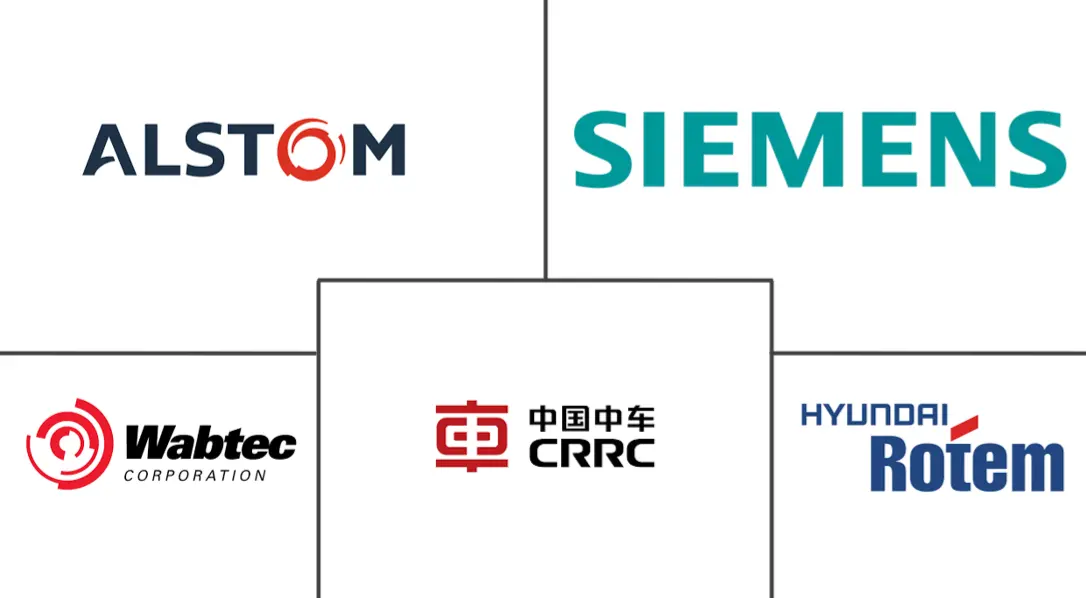Locomotive Market Size and Share
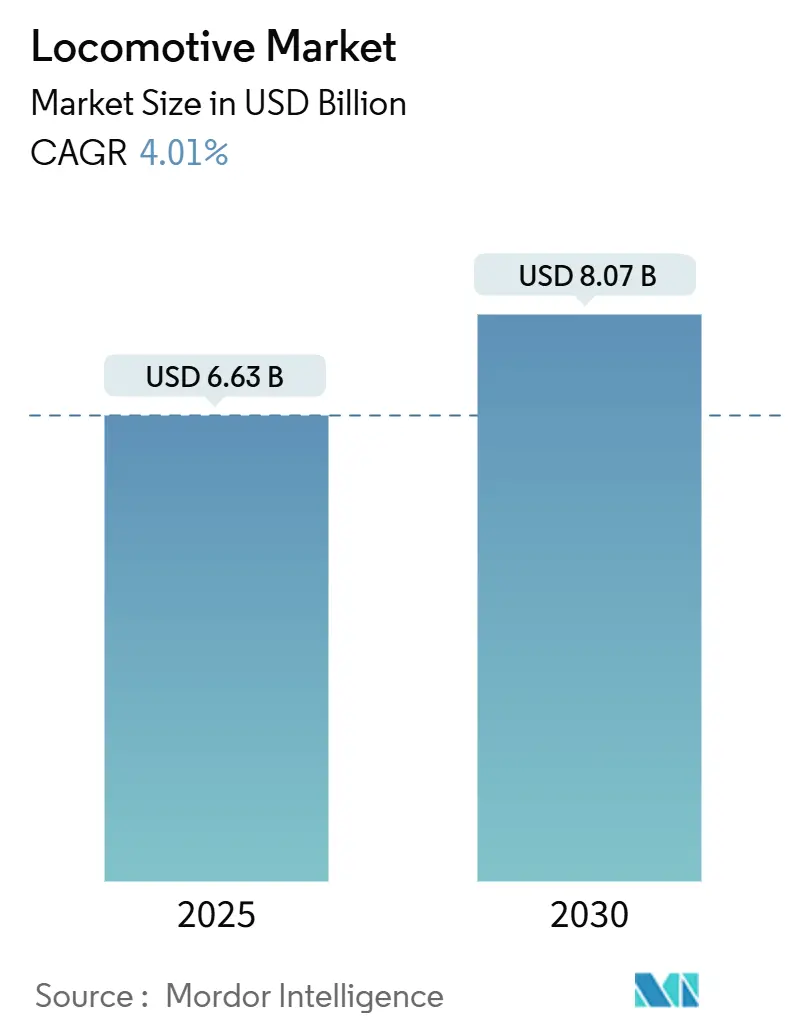
Locomotive Market Analysis by Mordor Intelligence
The Locomotive Market size is estimated at USD 6.63 billion in 2025, and is expected to reach USD 8.07 billion by 2030, at a CAGR of 4.01% during the forecast period (2025-2030). Strong government infrastructure spending, widening rail electrification schemes, and rising freight as well as passenger volumes underpin this steady expansion. Diesel platforms still dominate global fleets, yet every major procurement round now evaluates hybrid, battery-electric, or dual-mode options as operators look to curb emissions and lower lifetime energy costs. Technology upgrades in traction electronics and modular battery systems are shortening payback periods, while carbon-linked financing channels are broadening access to capital.
Key Report Takeaways
- By propulsion type, diesel platforms held 76.13% share of the locomotive market in 2024, while battery-electric units represent the fastest segment with a 4.61% CAGR to 2030.
- By technology, IGBT modules led with 64.22% of locomotive market share in 2024; Silicon Carbide modules are projected to grow at a 4.75% CAGR through 2030.
- By component, traction motors accounted for 42.32% share of the locomotive market size in 2024 and battery packs are advancing at a 4.38% CAGR through 2030.
- By locomotive type, freight units captured 66.31% of locomotive market share in 2024; high-speed passenger locomotives are expanding at a 5.33% CAGR to 2030.
- By power rating, the 2,000–4,000 kW class commanded 46.57% share of the locomotive market size in 2024, whereas units above 4,000 kW are growing at a 4.12% CAGR.
- By geography, Asia-Pacific led with 42.17% share of the locomotive market in 2024 and is forecast to rise at a 4.45% CAGR through 2030.
Global Locomotive Market Trends and Insights
Drivers Impact Analysis
| Driver | (~) % Impact on CAGR Forecast | Geographic Relevance | Impact Timeline |
|---|---|---|---|
| Growing freight & passenger rail volumes | +1.2% | Global, with concentration in Asia-Pacific and North America | Medium term (2-4 years) |
| Government-led rail electrification | +0.9% | Europe, China, India, with spillover to emerging markets | Long term (≥ 4 years) |
| Advancements in high-efficiency traction electronics | +0.7% | Global, led by technology centers in Germany, Japan, China | Short term (≤ 2 years) |
| Modular battery-electric & dual-mode retrofit | +0.6% | North America, Europe, with pilot programs in Australia | Medium term (2-4 years) |
| Carbon-credit & ESG financing lowers cost | +0.4% | Europe, North America, with emerging adoption in Asia | Medium term (2-4 years) |
| Predictive maintenance analytics | +0.3% | Global, with early adoption in developed markets | Short term (≤ 2 years) |
| Source: Mordor Intelligence | |||
Growing Freight & Passenger Rail Volumes Worldwide
Freight rail continues to gain share as shippers rebalance supply chains toward inland corridors, and rail’s cost advantage over long-haul trucking widens as fuel prices rise. Railways recorded a milestone in 2023, logging 429 billion passenger-kilometres (pkm), a notable jump from 386 billion in 2022, marking an 11.2% increase. This figure stands as the highest since data collection commenced in 2004[1]Eurostat, “Railway Passenger Transport Statistics,” ec.europa.eu. Operators are therefore procuring multi-purpose platforms that can toggle between freight and passenger duties, supporting standardization and fleet flexibility. Electric traction cuts energy cost by more than 50% compared with diesel on dense corridors, reinforcing the modal shift.
Government-Led Rail Electrification & Infrastructure Spend
Record public budgets are reshaping procurement cycles. The United States has earmarked USD 66 billion for rail upgrades, while the United Kingdom has set aside GBP 1 billion for the North Wales Mainline. Egypt’s USD 23 billion Siemens contract for 2,000 km of high-speed lines underscores the rapid modernization of emerging economies. These projects require new electric or dual-mode locomotives and trigger retirements of ageing diesel fleets. Operators hedge against patchy grid coverage by ordering locomotives with onboard batteries for first- and last-mile segments. The synchronized timing of national programs amplifies global demand, favoring builders that can scale deliveries quickly.
Advancements in High-Efficiency Traction Electronics (IGBT, SiC)
SiC devices are displacing conventional IGBT stacks in high-power converters thanks to lower switching losses and superior heat tolerance. Mitsubishi Electric’s 3.3 kV modules cut total losses by 15%, allowing smaller cooling packages and raising power density. Semikron Danfoss has launched hybrid SiC inverters tailored for auxiliary systems, balancing cost and efficiency. European research consortia target 20% traction energy savings by 2026 through full-SiC drives. As automotive production ramps up, SiC wafer output and rail applications benefit from falling prices and better supply security. Operators value longer maintenance intervals and higher reliability, translating into improved fleet availability and lower lifecycle spending.
Modular Battery-Electric & Dual-Mode Retrofit Solutions
Wabtec’s FLXdrive architecture, spanning 1.5–8.5 MWh, proves that modular batteries can scale to heavy-haul duty. Canadian National’s 3,200 hp hybrid pilot aims to cut diesel use by up to 50%. California’s rule phasing out locomotives over 23 years old by 2030 further incentivizes battery retrofits[2]California Air Resources Board, “In-Use Locomotive Regulation,” arb.ca.gov. Siemens’ Vectron packs integrate rechargeable modules for last-mile operation without catenary, extending route coverage. The retrofit model lets operators reuse existing frames and traction gear, turning capital outlays into staged upgrades instead of single-shot replacements.
Restraints Impact Analysis
| Restraint | (~) % Impact on CAGR Forecast | Geographic Relevance | Impact Timeline |
|---|---|---|---|
| High upfront procurement | -0.8% | Global, particularly acute in emerging markets | Long term (≥ 4 years) |
| Tightening emission rules | -0.6% | North America, Europe, with expanding coverage | Medium term (2-4 years) |
| Limited high-power battery supply chain | -0.5% | Global, with bottlenecks in lithium processing | Short term (≤ 2 years) |
| Grid-capacity bottlenecks | -0.4% | Europe, North America, with infrastructure lag | Long term (≥ 4 years) |
| Source: Mordor Intelligence | |||
High Upfront Procurement & Lifecycle Service Costs
Unit prices climb as new builds incorporate high-density batteries, SiC converters, and advanced digital control. India’s high-speed sets escalated from INR 389 crore to INR 460 crore per train between 2018 and 2023.[3]Indian Railways, “High-Speed Rail Procurement Updates,” indianrailways.gov.in Long-horizon service contracts add to cash flow strain, especially for publicly funded operators with capped budgets. Green bonds and ESG-linked loans help offset sticker shock, but many fleets still rely on phased renewal or leasing to manage capital risk. Manufacturers respond with locomotive-as-a-service models that bundle hardware, software, and maintenance into one fee, shifting some lifecycle responsibility back to suppliers.
Limited High-Power Battery Supply Chain for Heavy-Haul Use
Projected North American cell output will multiply 28-fold by 2035, yet gigawatt-hour gaps persist for rail-specific formats that prioritize power density over energy capacity. Lead times for traction-grade cooling plates and management systems have doubled since 2021, delaying deliveries. Heavy-haul locomotives often need packs above 5 MWh, a niche volume that lacks automotive scale economies. Dependence on Asian lithium processing introduces geopolitical risk, pushing OEMs toward vertical integration or long-term offtakes. Joint ventures between locomotive builders and battery specialists are becoming essential to secure guaranteed allocations.
Segment Analysis
By Propulsion Type: Diesel Dominance Faces Electric Disruption
The diesel platforms captured 76.13% of the locomotive market share in 2024. This diesel fleet endures because it can run on non-electrified lines that still cover more than half of global track mileage. Yet battery-electric units, expanding at a 4.61% CAGR, are benefiting from tightening emissions rules in California and the European Union. Operators valuing reliability retain diesel for heavy freight in Australia and North America, but dual-mode and battery tenders now populate every large order book. Overhead-electric models are also advancing as India orders 1,200 9,000 hp units from Siemens Mobility to optimize double-stack container routes. Dual-engine hybrids bridge the gap, letting carriers use clean traction in urban zones while relying on combustion on open stretches.
Zero-emission mandates are narrowing the cost gap rapidly. California confirmed commercial readiness for such fleets, prompting railroads to reassess asset strategies. Freight corridors seeking a single solution will likely deploy blended fleets, combining battery-electric on grades and diesel on long plains, until universal electrification arrives. This multi-vector transition underscores the fluid nature of the locomotive market.
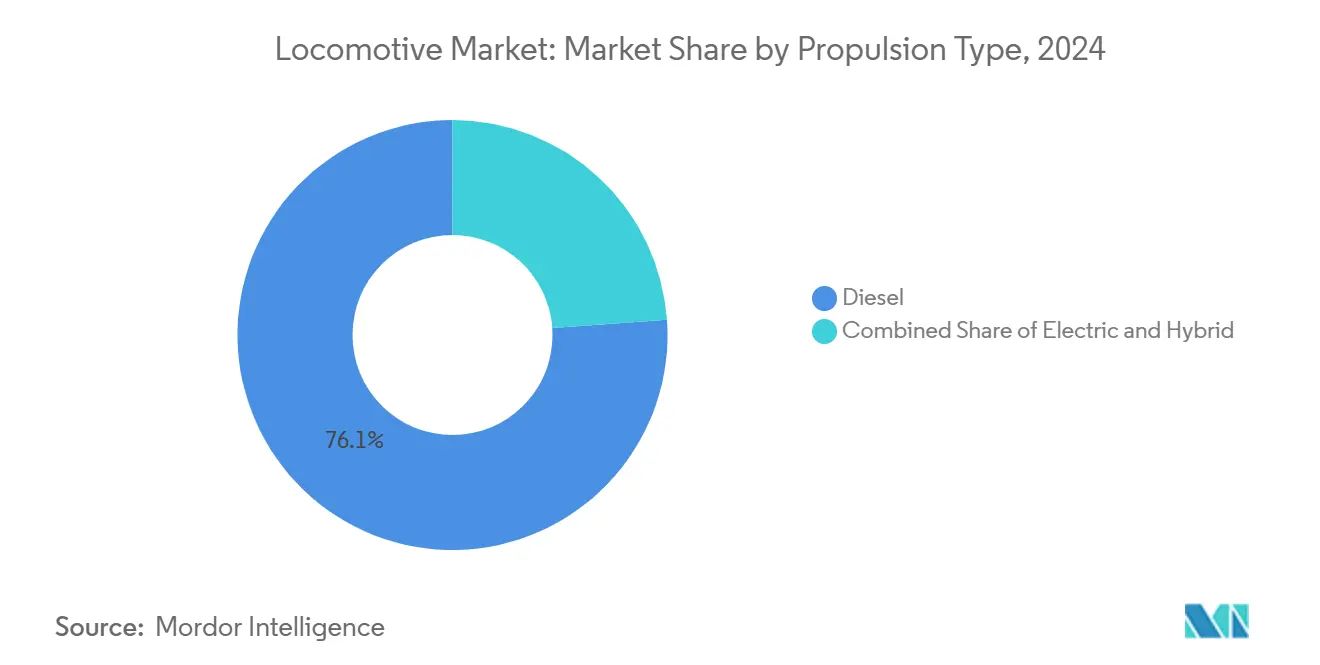
Note: Segment shares of all individual segments available upon report purchase
By Technology: IGBT Leadership Challenged by SiC Innovation
IGBT converters represented the largest slice of the locomotive market share at 64.22% in 2024 because of proven reliability and economies of scale. Continuous improvements—such as Mitsubishi Electric’s moisture-resistant packaging—sustain their competitiveness in harsh rail environments. GTO thyristors linger in legacy heavy-haul units, while MOSFETs serve niche auxiliary loads. Emerging SiC devices, though, are growing at 4.75% annually as railways chase higher efficiency.
SiC-based systems trimmed two windings from the transformer and slashed leakage inductance by 75%. While the weight saw a 5% uptick, the SiC MOSFET achieved a notable 20% dip in transformer losses. Semikron Danfoss’ hybrid modules demonstrate an incremental path, allowing operators to swap in SiC on high-heat stages while retaining lower-cost silicon elsewhere. As manufacturing yields climb, pure-SiC stacks should win more tenders, especially for high-speed passenger trains where power density and cooling space are at a premium.
By Component: Traction Motors Lead Amid Battery Pack Surge
Traction motors held 42.32% of locomotive market size in 2024 due to their indispensable role in propulsion. AC synchronous platforms are gradually replacing DC units, delivering better torque control and reduced maintenance needs. Hitachi’s copper die-cast rotor cut motor mass by 15 kg, illustrating ongoing incremental gains. Inverters and rectifiers remain critical, coordinating power flow between engines, batteries, and grid connections.
Battery packs, however, are the breakout story with a 4.38% CAGR. Wabtec’s FLXdrive demonstrates modular stacking that tailors capacity to route energy needs. Fuel-cell stacks for hydrogen prototypes constitute a nascent yet intriguing component line, particularly for desert and mountain corridors where catenary construction is difficult. As fleets adopt hybridization, suppliers must master integrated packages that combine traction motors, inverters, cooling, and storage in one envelope, shifting competition from single components to full drivetrain solutions.
By Locomotive Type: Freight Dominance Meets High-Speed Growth
Freight commanded 66.31% of the locomotive market share in 2024 thanks to robust international trade lanes and heavy-haul mining operations. Wabtec’s Tier 4 Evolution unit shows how builders optimize tractive effort while complying with strict emissions rules. Passenger models prioritize rapid acceleration and crashworthiness, serving dense commuter corridors. Shunters carve a smaller but stable niche, focused on yard logistics.
High-speed passenger locomotives stand out with a 5.33% CAGR to 2030. Korea’s KTX-CheongRyong sets a benchmark at 320 km/h. India is pursuing indigenous 250 km/h designs under a Rs 8.67 billion pilot order. Many builders now offer universal platforms capable of both freight and passenger service by swapping gear ratios and software, reflecting operators’ need for asset versatility.
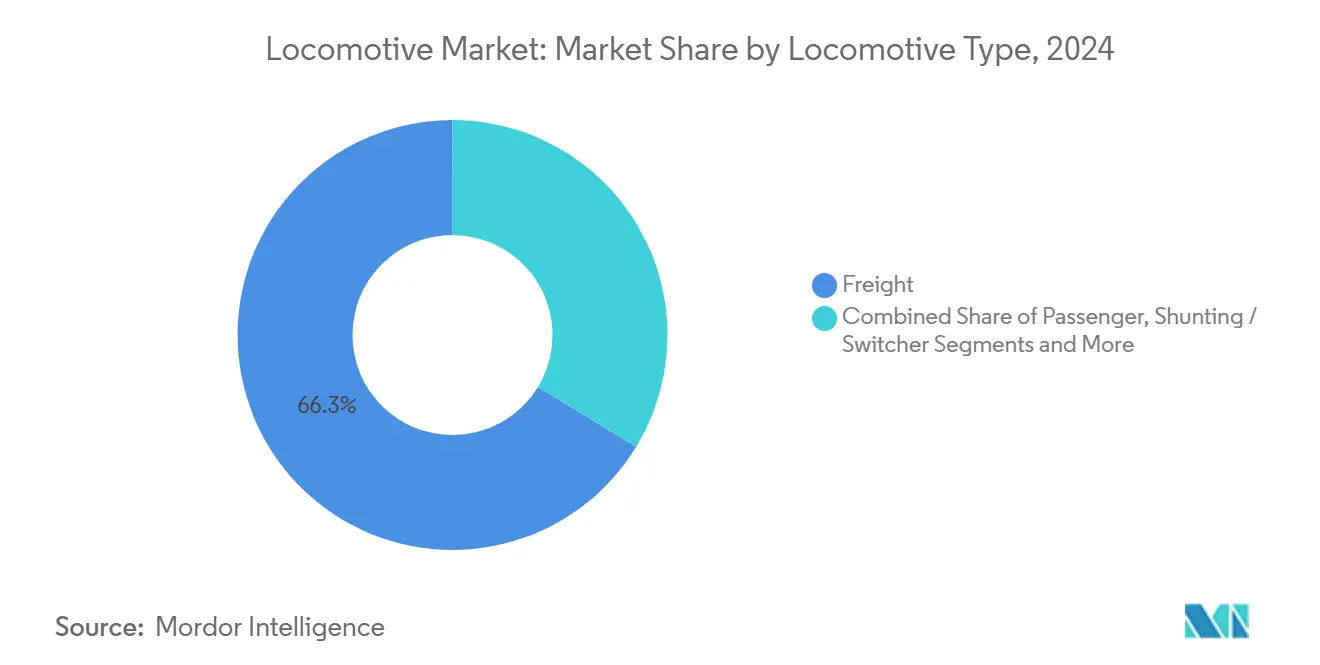
Note: Segment shares of all individual segments available upon report purchase
By Power Rating: Mid-Range Leadership Amid High-Power Expansion
Units rated 2,000–4,000 kW held 46.57% of locomotive market size in 2024, fitting most mixed-traffic tasks. They balance tractive effort and energy consumption without overstressing track infrastructure or maintenance shops. Below-2,000 kW locomotives remain popular for switching and regional passenger roles, where agility outweighs brute force.
The segment above 4,000 kW is growing fastest at 4.12% as railways consolidate consists. CRRC’s HX series at 10,000 kW hauls 5,000-ton loads, reducing locomotive counts per train. Indian Railways’ 9,000 hp freight electrics aim to run double-stack containers at 120 km/h, elevating line capacity without new tracks. Higher-power units support both operational efficiency and lower emissions per tonne-kilometer, aligning with ESG targets.
Geography Analysis
Asia-Pacific generated the largest regional revenue and owned 42.17% of the locomotive market in 2024. China’s CRRC spearheads most high-speed exports, while India placed the world’s largest single locomotive order with Siemens Mobility for 1,200 freight electrics. Japan continues to refine Shinkansen technology, and South Korea’s newly launched KTX-CheongRyong emphasizes regional leadership in distributed-power systems. Australia’s iron ore lines, piloting Wabtec’s battery-electric FLXdrive, highlight mining’s role in shaping demand. Public funding, escalating urbanization, and domestic manufacturing policies together underpin Asia-Pacific’s 4.45% CAGR through 2030.
North America hosts a mature yet transforming locomotive market. Class I railroads extend train length and tonnage, spurring demand for higher-power units. California’s regulation barring locomotives older than 23 years from 2030 drives an accelerated replacement wave toward battery or hydrogen platforms. The USD 66 billion federal infrastructure package bolsters both passenger corridors and freight bottlenecks, sustaining procurement volumes through the decade.
Europe continues its long-standing push for sustainable rail. Passenger travel reached a record 429 billion passenger-km in 2023, supporting new high-speed orders such as Alstom’s Avelia Horizon. Freight remains under competitive pressure, yet regulatory decarbonization targets safeguard investment in modern locomotives. Germany maintains a central manufacturing and operating position, while the UK expands electrification on mainlines like North Wales.
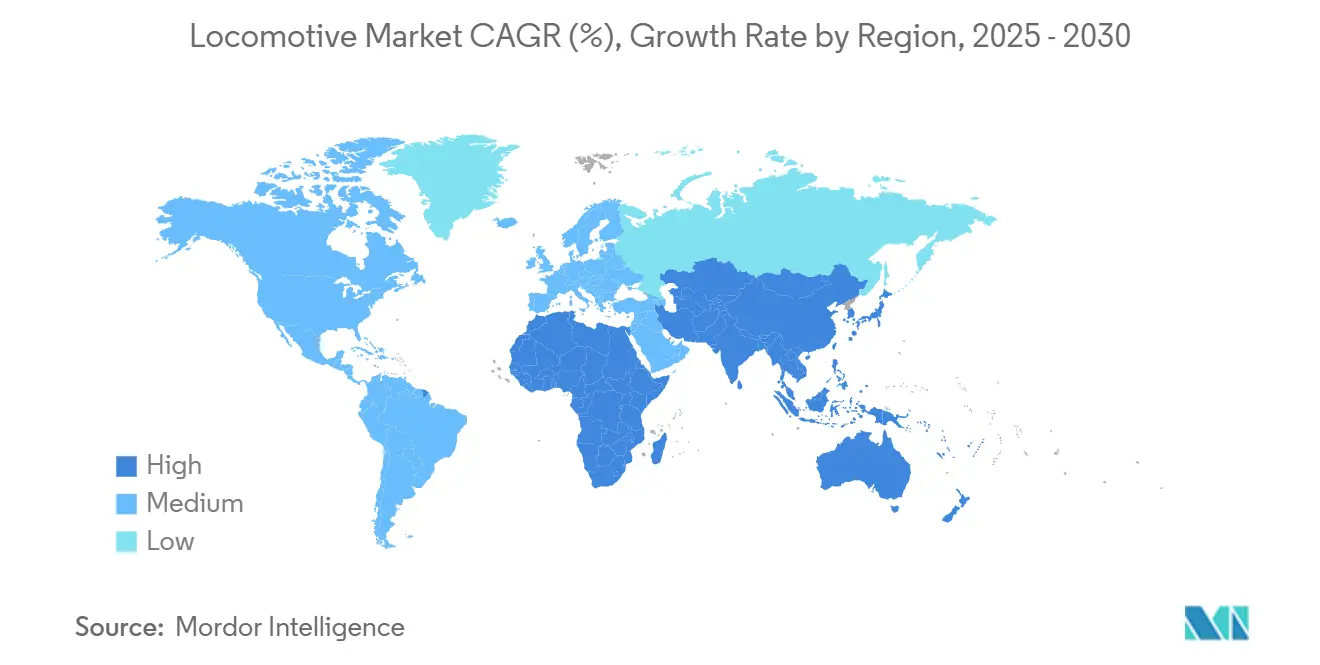
Competitive Landscape
The locomotive market features moderate concentration. CRRC, Alstom, Siemens, and Wabtec collectively control a significant share thanks to broad portfolios and multi-continent production networks. CRRC alone holds more than two-fifths of the global high-speed manufacturing, evidencing the advantage of scale and government backing. Alstom and Siemens use technology depth in signaling and complete trainsets to cross-sell locomotives alongside turnkey projects.
Competition is sharpening around decarbonization technologies rather than headline pricing. Builders race to commercialize battery-electric, hydrogen, and SiC-based systems that meet tough emissions caps with lower lifecycle cost. Strategic partnerships are proliferating: Hyundai Rotem’s USD 664 million LA Metro deal leverages local assembly to satisfy Buy America rules, and technology alliances share R&D risk on next-gen drives.
Market newcomers exploit niche openings. Firms specializing in mining locomotives, modular retrofits, or hydrogen fuel stacks enter without confronting full-service incumbents directly. Automotive suppliers of batteries and power electronics are also eyeing rail segments, bringing scale economies that could disrupt traditional supply chains. Service-centric models such as locomotive-as-a-service further reshape competitive value propositions by tying revenue to fleet uptime instead of unit sales.
Locomotive Industry Leaders
-
Alstom SA
-
Siemens AG
-
Hyundai Rotem
-
CRRC Corporation Limited
-
Wabtec Corporation
- *Disclaimer: Major Players sorted in no particular order

Recent Industry Developments
- May 2025: Kinkisharyo International (KILLC) has inked a deal with Hyundai Rotem USA to handle the final assembly of 182 new railcars, with an option for 50 more, destined for the Los Angeles Metropolitan Transportation Authority (LA Metro).
- May 2025: Siemens India has rolled out India's inaugural 9000 HP electric locomotive, with key components crafted at its facilities in Nashik, Aurangabad, and Mumbai.
- April 2025: Alstom has announced an investment plan of over EUR 150 million to boost production capacity at its French sites. This move is in response to surging demand in both French and global rail markets, with a special focus on very high-speed trains.
Research Methodology Framework and Report Scope
Market Definitions and Key Coverage
Our study defines the global locomotive market as the annual factory-gate value of newly built self-propelled rail vehicles that supply traction power to passenger and freight trains, whether by diesel-electric, pure electric, dual-mode, battery, or hydrogen propulsion. The valuation captures the ex-works price of the complete unit, including traction drive, control electronics, and onboard auxiliary systems, at first sale to rail operators or rolling-stock leasing companies.
Scope exclusion: refurbishment, mid-life overhauls, and maintenance service revenues are deliberately left out.
Segmentation Overview
- By Propulsion Type
- Diesel
- Electric (Overhead)
- Hybrid
- By Technology
- IGBT Module
- GTO Thyristor
- SiC Module
- MOSFET Module
- By Component
- Traction Motor
- Inverter
- Rectifier
- Alternator
- Transformer
- Battery Pack
- Fuel Cell Stack
- By Locomotive Type
- Freight
- Passenger
- Shunting / Switcher
- High-Speed
- By Power Rating (kW)
- Below 2,000 kW
- 2,000 to 4,000 kW
- Above 4,000 kW
- By Geography
- North America
- United States
- Canada
- Rest of North America
- South America
- Brazil
- Argentina
- Rest of South America
- Europe
- Germany
- United Kingdom
- France
- Italy
- Russia
- Rest of Europe
- Asia-Pacific
- China
- India
- Japan
- South Korea
- Australia
- Rest of Asia-Pacific
- Middle East and Africa
- Saudi Arabia
- United Arab Emirates
- Egypt
- Turkey
- South Africa
- Rest of Middle East and Africa
- North America
Detailed Research Methodology and Data Validation
Primary Research
Mordor analysts interviewed rolling-stock procurement managers on three continents, senior engineers at leading OEMs, and government rail-planning officials. These conversations validated electrification timelines, average contract lead times, and replacement cycles, and they calibrated preliminary volume estimates derived from desk research.
Desk Research
We began with public datasets that track rail capacity additions, such as International Union of Railways fleet bulletins, UN Comtrade customs codes for HS 8601/8602 deliveries, the European Railway Agency's annual vehicle authorizations, and the US Federal Railroad Administration procurement filings. Statistics from national transport ministries in India, China, and Germany enriched regional delivery splits, while company filings and investor presentations clarified average selling prices. Paid intelligence from D&B Hoovers and Marklines helped us benchmark manufacturer revenue streams and model production runs. The sources listed are illustrative; numerous additional databases and trade journals were reviewed to confirm figures and resolve discrepancies.
The output from these repositories built the foundational demand pool. Trend articles and patent grants (Questel) signaled emerging SiC traction modules and battery pack design shifts that affect future unit pricing.
Market-Sizing & Forecasting
A top-down reconstruction of global locomotive deliveries was performed by pairing country-level production and import totals with prevailing ex-works ASP brackets. Sampled bottom-up cross-checks, supplier roll-ups, and channel spot quotes then fine-tuned aggregate value.
Key variables in the model include electrified-track share, average power-rating mix, fleet retirement age, and capital-budget allocations announced under stimulus bills. Forecasts to 2030 were generated through multivariate regression that links locomotive demand to freight-ton-kilometers, passenger-rail ridership, and electrification capex, with scenario ranges vetted by interviewed experts.
Data Validation & Update Cycle
Outputs pass three-stage reviews: variance screening against historical fleet patterns, anomaly investigation by a second analyst, and sign-off by the sector lead. We refresh the dataset each year and reopen the model sooner if policy shocks, such as large funding bills or emission norms, materially alter underlying drivers.
Why Mordor's Locomotive Market Baseline Inspires Decision-Maker Confidence
Published estimates vary because firms choose different inclusion rules, base-year price assumptions, and refresh cadences. Mordor restricts scope to first-sale vehicle revenues, applies country-specific ASP ladders, and revisits inputs annually, which keeps our baseline closely tethered to observable production and trade datapoints.
Key gap drivers versus external figures often stem from competitors bundling refurbishment contracts, spreading ASPs from high-speed units across all types, or rolling forward historical exchange rates without parity checks.
Benchmark comparison
| Market Size | Anonymized source | Primary gap driver |
|---|---|---|
| USD 6.63 B (2025) | Mordor Intelligence | - |
| USD 25.6 B (2025) | Regional Consultancy A | Includes maintenance and track electrics; unit ASPs averaged at fleet level |
| USD 13.8 B (2024) | Global Consultancy B | Uses historical exchange rates and groups shunting locomotives with railcars |
In sum, by isolating new-build traction units, triangulating volumes with customs and production logs, and stress-testing prices through both procurement insiders and financial disclosures, Mordor Intelligence offers a balanced baseline that users can trace back to clear, repeatable inputs.
Key Questions Answered in the Report
What is the current locomotive market size and growth outlook?
The locomotive market generated USD 6.63 billion in 2025 and is projected to reach USD 8.07 billion by 2030 with a 4.01% CAGR.
Which region leads the locomotive market?
Asia Pacific maintains leadership with 42.17% share in 2024 and continues to expand thanks to large-scale projects in China and India.
Which propulsion technology is growing fastest?
Battery-electric locomotives are the fastest-growing propulsion type, advancing at a 4.61% CAGR through 2030 as zero-emission mandates tighten.
What component segment shows the highest growth?
Battery packs top component growth at a 4.38% CAGR because energy storage is integral to hybrid and electric platforms.
How are regulations impacting the locomotive market?
Policies such as California’s ban on locomotives older than 23 years from 2030 and extensive electrification funding in the United States and Europe are accelerating fleet renewal toward low-emission models.
Which companies dominate global locomotive manufacturing?
CRRC, Alstom, Siemens, and Wabtec hold the largest combined share.
Page last updated on:
